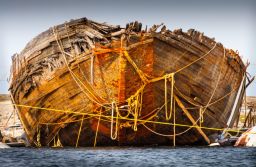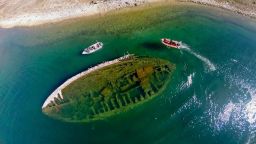Story highlights
The Maud was raised to the surface after 85 years under water
The vessel was captained by arctic explorer Roald Amundsen
The ship will be making her journey back home to Norway next year
A ship that once belonged to famed Norwegian arctic explorer Roald Amundsen has been recovered after almost a century immersed in the icy depths of Cambridge Bay in Canada.
The Maud was one of three iconic ships built for Amundsen’s expeditions, alongside Gjøa and Fram, which are today on display at the Fram Museum in Oslo, Norway.

After six years of work, the team of Norwegians behind the project were able to do what was attempted in the 1990s but ended in failure – they raised the Maud after 85 years on the Canadian seabed.
Despite decades under water, the Maud is expected to have maintained much of its integrity.

The Maud was launched on June 7, 1917, in Vollen, near Oslo. The vessel was christened by Amundsen. The renowned explorer later captained the ship during an expedition to the Northeast Passage above Russia. The Maud was then sold in 1925 and by 1931 she had sunk after getting trapped in ice. The Maud had been lying in Cambridge Bay ever since.
Project manager Jan Wanggaard described the moment he saw The Maud rising to the surface.
“In one moment all our questions diluted into silence and I let myself sink slowly down to greet the old lady Maud, who finally had let go. She was free again after all these years,” said Wanggaard.
Ship rose ‘like a Queen’
.”She came, slowly, with grace, just like a Queen would,” he added.

The process of bringing the Maud back to the surface involved a lot of rope and large airbags. After an unsuccessful attempt to lift the ship in 2015, the team returned this summer with more flotation devices.
A huge part of the work involved cleaning out the inside of the ship. “Tons of mud has been dug out from every room inside the old ship. It’s been an exciting process despite being very dirty and tiring,” Wanggaard said.

The team are now one step closer to bringing their national treasure home. The Maud is expected to begin the journey back to Norway by summer 2017. That slow, final journey will cover 3,700 nautical miles (7,000 kilometers).
Wanggaard sees the project as an important success.
“The Maud expedition story, and the story of Amundsen himself, is powerful and full of endless tales about human beings with strong will and courage to push limits and explore the mysteries of life and nature,” he said.



